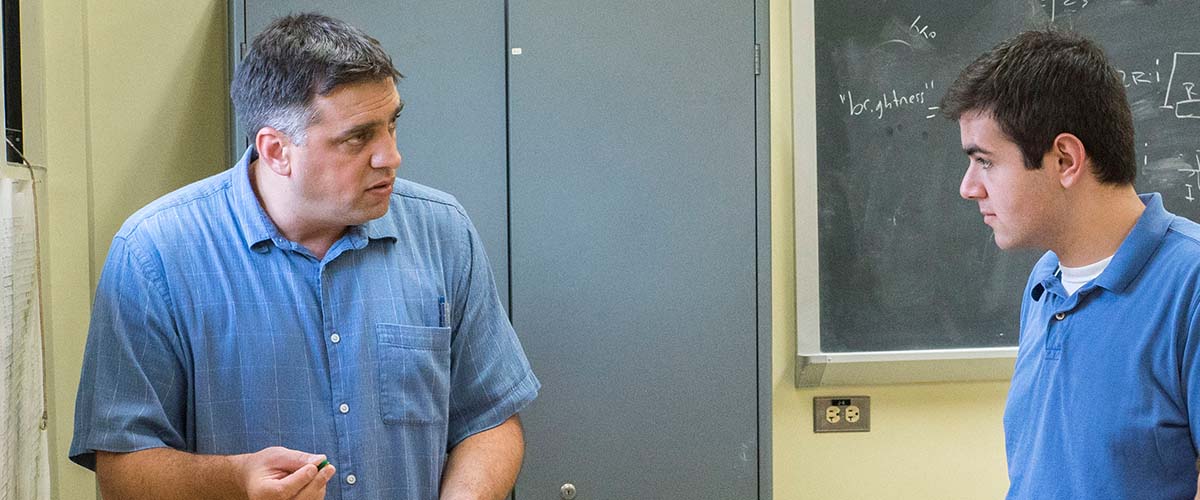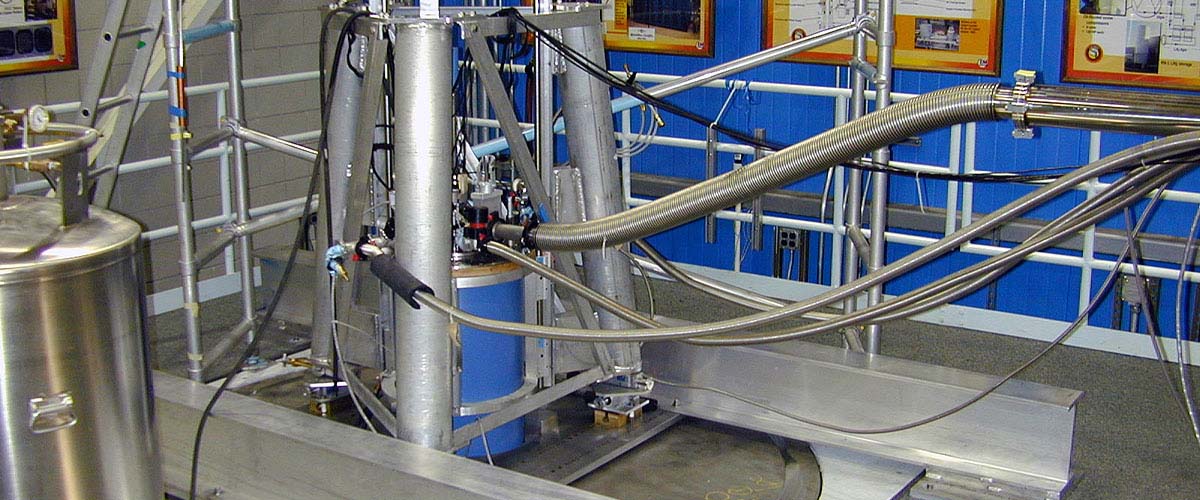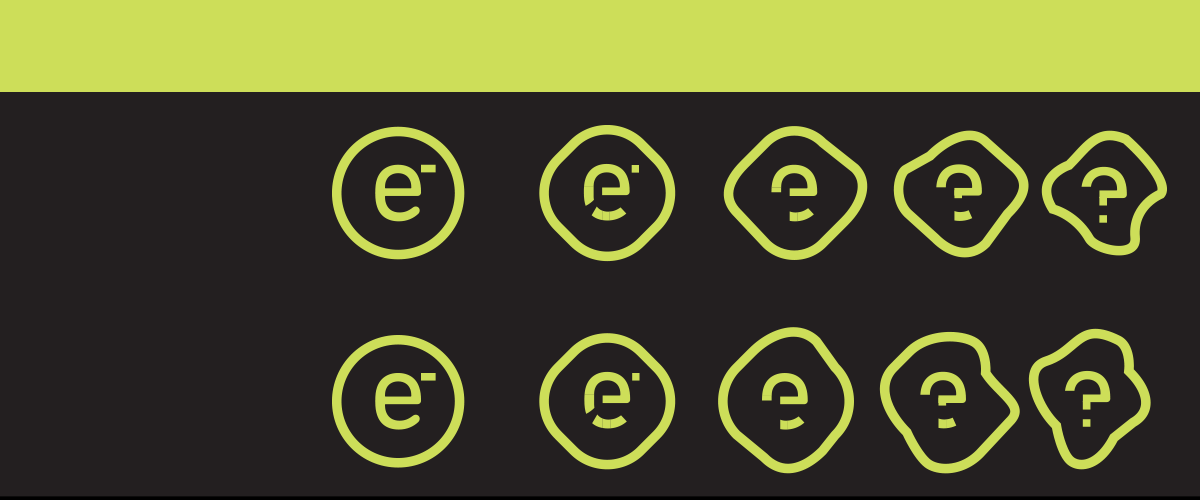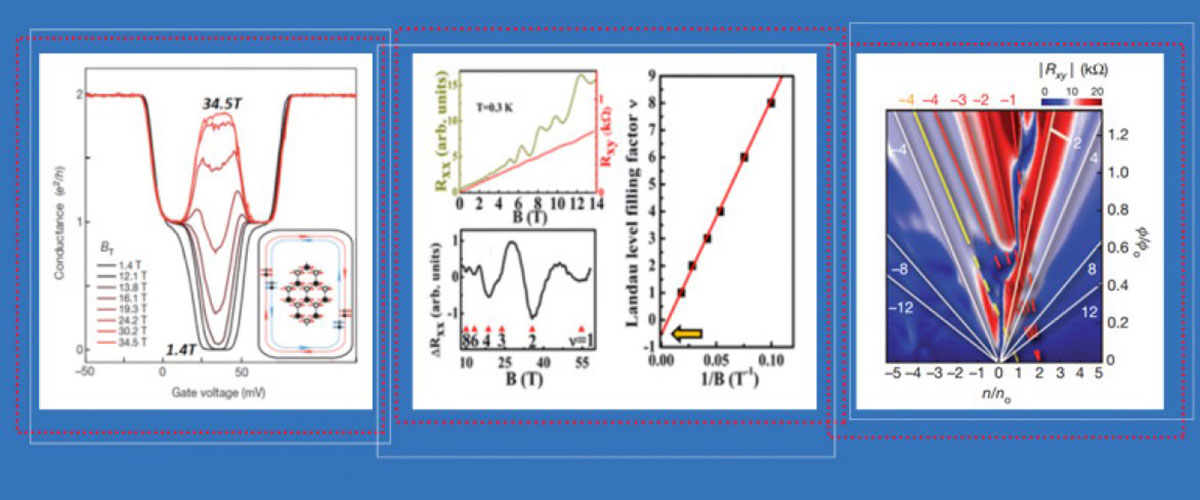Sometimes, you have to go back to go forward. Sounds strange, but it's what one MagLab physicist did when he harnessed the sun's primordial power to solve a perplexing, high-tech problem. As helpers, he had two unlikely candidates: a rural elementary-school teacher and a college
undergrad.
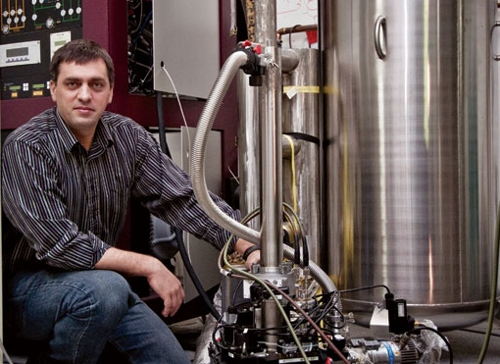
Physicist Irinel Chiorescu beside his lab's pit magnet.
At the heart of scientist Irinel Chiorescu's dilemma — and his research — is something so teeny, you can't even see it under a microscope: a photon, an elusive bundle of radiant energy. Chiorescu (Key-oh-REZ-coo) studies this mysterious unit of energy in hopes of creating the first quantum computer.
"In our research projects, we are measuring the energy of one single photon — and the energy of one single photon is very, very small," said Chiorescu, who earned his advanced degrees from France's Joseph Fourier University in Grenoble.
Small signal, big catch
Most days, you can find the tall, Romanian researcher hovered over his "pit magnet" — a 200-pound, refrigerator-sized machine sunk right into the floor. His experiments are all done inside of it, so everything in his lab happens around the man-made magnet.
"We are studying very small signals," said Chiorescu, an associate physics professor at Florida State University. "We need to amplify the signal so that it's easily readable and something we can measure."
To do that, he uses special electronic amplifiers to crank up the volume. But there's a catch: When he amps up the sound of the weak signals, he also increases something he doesn't want: electrical noise. The electricity that powers our homes contains noise that — even though we can't hear it — can wreak havoc in super-sensitive experiments.
The plan
To reduce this unwanted buzz, scientists often turn to battery power. Chiorescu, however, wanted to try solar-powered batteries. He hoped that, in addition to being environmentally friendly, solar power would prove to be ultra-clean (i.e., noise-free), too.
To see if his idea would work, the FSU Physics Department awarded him a $7,500 grant.
"The project scientifically is very interesting and very important," said Mark Riley, the chair of FSU's Physics Department. "New ways of utilizing solar power should be encouraged."
No sooner had Chiorescu received the grant than two eager assistants arrived: a fifth-grade teacher and a University of California at Berkeley undergraduate. Together, they brainstormed a plan of action: Create a model, then have MagLab staff install solar panels, build a battery console and wire the system.
It's about challenges
Chiorescu's industrial lab — with its electronic consoles, large liquid-helium containers and a wall featuring hand-written equations and diagrams — is a vastly different space from Jodie Martin's bright classroom full of student art at Medart Elementary School in Crawfordville.
But Martin wanted to challenge herself over the summer break. So she applied to the MagLab's Research Experiences for Teachers, a summer program that pairs K-12 teachers with scientists for an intensive, six-week plunge into real-world science.
And a challenge it was, she said.
"I did learn a lot about solar energy, but I also learned so much more. I learned more about the (periodic table of) elements, and now I can talk about silicon and how it's used in solar panels and how it allows electrons to move more easily."
Chiorescu also mentored undergraduate Akshita Dutta, a sophomore at the University of California at Berkeley and one of 22 students selected for the lab's Research Experiences for Undergraduates summer program.
The two women put their heads together and came up with a working model of a solar-energy storage system — which Martin later kept to use with her fifth-graders. Having three sons at home has shown her that the model definitely captures kids' attention.
"Every one of my three boys couldn't resist playing with it," she said. "They've all had to take it outside and see how much sun they could store with it."
Unexpected bonuses
But Martin gained other insights at the lab, too.
"I felt the frustration a student feels trying to learn something new. There were times when I got very, very frustrated and really just wanted to give up."
She struggled with advanced math calculations until she convinced herself she couldn't do them. Chiorescu, however, insisted she could.
"He said, 'Oh, students often make this mistake. I'm not going to help you because I know that you can figure it out.'"
That same evening, the worried Martin surprised herself — by doing the math.
"The next day, I thanked him. After I got it figured out, I was so confident in myself, I felt like I could do anything!"
She wants the memory of that exhilaration to guide her with her own students when she sees them struggling.
Dutta, a chemical-engineering major, likewise came away from her lab internship with an unexpected bonus. At Chiorescu's urging, she wrote a paper, "Solar Panels as a Source of Noise-Free Power," and presented it at her university's undergraduate research symposium.
"It was a fantastic experience," Dutta said. "It motivated me to try and apply what I learn in my classes to the real world."
Up and running
After the teacher-student team completed its work, it was time for MagLab staff — Andy Powell, an electronics engineer, Richard Brooks, the maintenance and construction superintendent, and others — to jump in and make the project a reality.
They built a portable, electronic console to house eight batteries (each about 50 pounds and a bit bigger than a car battery). They mounted three solar panels on the roof above Chiorescu's lab, and then wired the system to the magnet. Fortunately, the grant covered all the material expenses.
"The physics department has a history of encouraging outstanding young faculty, and this is an example of us doing that," said Riley, the department's chair. "Irinel is doing fabulous work out at the MagLab."
In December, Chiorescu began using the solar-energy system to power his amplifiers and the data-acquisition stage of his experiments.
Ask him about the outcome today, and he smiles.
"The signal is 50 times better now," the professor said. "I am very happy with the results."
This story was originally published in Issue 7 of flux magazine, a discontinued publication of the National High Magnetic Field Laboratory.
By Kathleen Laufenberg



